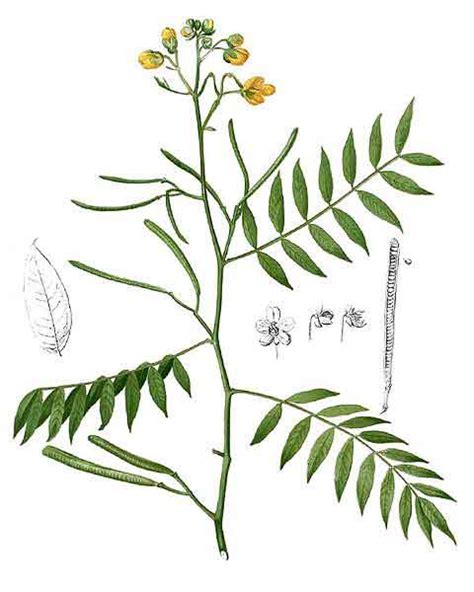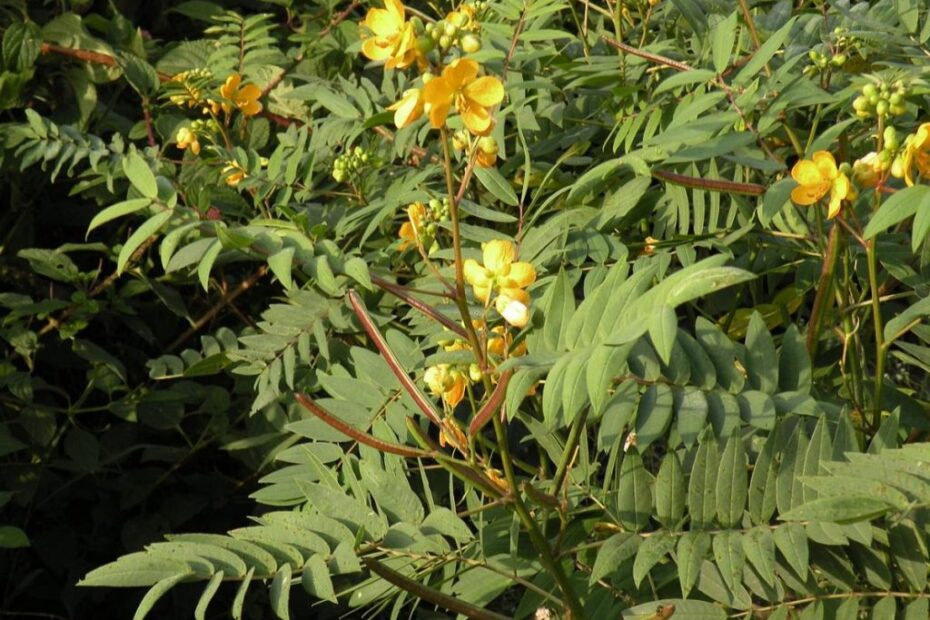Cassia occidentalis, commonly known as Coffee Senna, Negro Coffee, or Kasamarda, is a versatile medicinal plant belonging to the Fabaceae family (subfamily Caesalpinioideae). This erect, annual or perennial herb is widely distributed in tropical and subtropical regions, including India, Africa, South America, and the Caribbean. It is a significant plant in traditional medicine systems such as Ayurveda, Unani, Siddha, and African and Chinese traditional medicine, valued for its diverse pharmacological properties and phytochemical richness. Below is a detailed herbal profile covering its botanical characteristics, phytochemistry, medicinal uses, pharmacological activities, toxicity, and cultivation considerations.
1. Botanical Description
- Scientific Name: Cassia occidentalis L. (Synonym: Senna occidentalis (L.) Link)
- Family: Fabaceae (Caesalpinioideae)
-
Common Names:
- English: Coffee Senna, Negro Coffee, Stinking Weed, Fetid Cassia
- Hindi: Kasaundi, Bari Kasaundi
- Ayurveda: Kasamarda, Kaasaari
- Unani: Kasondi
- Siddha/Tamil: Paeyaavarai, Thagarai
- Telugu: Kasinda
- Malayalam: Ponnaviram, Ponnarviriam
- Kannada: Doddaagace
-
Morphology:
- Habit: Erect, somewhat branched, annual or short-lived perennial herb or undershrub, growing 0.8-1.8 meters tall with a taproot system (15-25 cm long, 1-1.5 cm in diameter).
- Stem: Smooth, cylindrical, slightly woody, and glabrous or sparsely hairy.
- Leaves: Pinnate, alternate, 6-12 inches long, with 4-6 pairs of leaflets. Leaflets are ovate to lanceolate, 1.5-4 inches long, bluish-green to pale green, pubescent, with paracytic stomata and prismatic calcium oxalate crystals in cortical cells. A tubercular gland is present on the petiole.
- Flowers: Pale yellow, inconspicuous, arranged in short axillary or terminal racemes, with 2-4 flowers per peduncle.
- Pods: Linear, plano-compressed, 3-4 inches long, brown with pale margins, containing obovate, dark brown seeds.
- Seeds: Oblong, dark brown, obovate, 3-5 mm long, used as a coffee substitute in some regions.
- Habitat and Distribution: Thrives in wastelands, barren soils, and marginal lands in tropical and subtropical climates. It is drought-resistant and grows as a rain-fed or irrigated crop in regions like Tamil Nadu, India (e.g., Ramanathapuram, Madurai, Tiruchirappalli, and Tirunelveli districts). It is naturalised in parts of South Africa, the West Indies, and other tropical areas [1, 4].
2. Phytochemical Composition
Cassia occidentalis is rich in bioactive compounds, contributing to its therapeutic potential. The phytochemical profile varies by plant part (leaves, seeds, roots, stems, flowers) and is influenced by geographical location and season. Key phytochemicals include:
-
Anthraquinones and Derivatives:
- Achrosin
- Aloe-emodin (1,8-dihydroxy-3-hydroxymethylanthraquinone)
- Emodin (1,6,8-trihydroxy-3-methylanthraquinone)
- Chrysophanol (1,8-dihydroxy-3-methylanthraquinone)
- Rhein (1,8-dihydroxy-3-carboxylic acid anthraquinone)
- Physcion<
- Aurantiobtusin, chryso-obtusin, obtusifolin, obtusin
-
Flavonoids:
- Apigenin
- Chrysoeriol
- Kaempferol
- Quercetin
- Vitexin
- Rhamnosides
-
Sterols:
- Campesterol
-
Other Compounds:
- Cassiollin (anthrone)
- Chrysophanic acid
- Chrysarobin
- Essential oils
- Funiculosin
- Helminthosporine
- Islandicine
- Matteucinol
- Lignoceric acid, linoleic acid, linolenic acid, oleic acid
- Mannitol, mannopyranosyl
- Tannins, phenols, alkaloids, saponins, terpenes, resins, balsams, anthocyanosides, proteins, amino acids (leucine, histidine, proline, glycine), cardiac glycosides, carbohydrates, sugars
-
Minerals and Nutrients:
- High in iron (Fe), calcium (Ca), potassium (K), manganese (Mn), magnesium (Mg), zinc (Zn), copper (Cu), sodium (Na), phosphorus (P), sulfur (S).
- Seeds are a good source of vitamin B3 (niacin) and alternative plant “proteins”.
-
Analytical Techniques:
- Confirmed through gas chromatography-mass spectrometry (GC-MS), high-performance thin-layer chromatography (HPTLC), and X-ray fluorescence spectrophotometry [1, 2, 6, 9].
3. Traditional and Ethnomedicinal Uses
Cassia occidentalis has a long history of use in traditional medicine across cultures, including Ayurveda, Unani, Siddha, Traditional Chinese Medicine (TCM), and African traditional medicine. Its applications vary by plant part and preparation:
-
Leaves:
- Applied topically as a paste to treat skin infections (e.g., ringworm, eczema, wounds, rashes, rabies).
- Used in decoctions for fever, cough, and tuberculosis.
- Anti-inflammatory and wound-healing properties.
-
Seeds:
- Used as a coffee substitute (hence the name Coffee Senna).
- Purgative, carminative, and diuretic; used for constipation, whooping cough, and heart disease.
- In TCM, seeds (Jue Ming Zi) are used to clear liver heat, soothe inflamed eyes, and aid sleep or constipation.
-
Roots:
- Extracts used for fever, neuralgia, dropsy, and as an antidote for poison.
- Anti-pyretic and hepatoprotective properties.
-
Flowers:
- Decoctions used to treat asthma and bronchitis.
-
Whole Plant:
- Used for jaundice, liver disorders, diabetes, rheumatism, typhoid, asthma, leprosy, haemoglobin disorders, and as a blood purifier.
-
Specific Cultural Uses:
- Ayurveda: Known as Kasamarda, used for cough (Kasa), liver tonics (e.g., Liv.52), and eye inflammations.
- Unani: Kasondi, used for liver health and skin conditions.
- Siddha/Tamil: Paeyaavarai, used for diarrhea, dysentery, and fever.
- Jamaican Folk Medicine: Treats diarrhoea, dysentery, constipation, fever, cancer, and venereal diseases.
- African Traditional Medicine: Used for malaria, yellow fever, cholera, and as a poison antidote [1, 2, 3, 7, 8].

4. Pharmacological Activities
Cassia occidentalis exhibits a wide range of pharmacological activities, supported by preclinical and some clinical studies. These activities are attributed to its diverse phytochemicals, particularly anthraquinones, flavonoids, and alkaloids.
-
Antibacterial Activity:
- Effective against Bacillus subtilis, Klebsiella pneumoniae, Pseudomonas aeruginosa, Neisseria gonorrhoeae, and other pathogens.
- Leaf and seed extracts inhibit bacterial growth, useful for skin infections and diarrhoea.
-
Antifungal Activity:
- Inhibits fungal growth (e.g., Candida spp.), useful for dermatological conditions like ringworm.
-
Antimalarial Activity:
- In vitro and in vivo studies show activity against Plasmodium falciparum and Plasmodium vivax. Root extracts inhibit parasite growth in mice.
-
Anti-inflammatory Activity:
- Reduces inflammation via inhibition of pro-inflammatory cytokines (IL-6, TNF-α). Effective in wound healing and UV radiation-induced skin damage.
-
Antioxidant Activity:
- Flavonoids and phenols scavenge free radicals, increasing levels of antioxidant enzymes (CAT, SOD, GSH) and reducing oxidative stress (MDA).
-
Antidiabetic Activity:
- Aqueous and ethanolic extracts reduce fasting blood glucose in normal and alloxan-induced diabetic rats. Effective from day 7-14 of treatment.
-
Hepatoprotective Activity:
- Protects against liver damage in conditions like hepatitis, alcoholic liver disease, non-alcoholic fatty liver disease (NAFLD), and drug-induced hepatotoxicity. Used in formulations like Liv.52.
-
Neuroprotective Activity:
- Ethanolic root extracts improve memory and reduce oxidative stress in colchicine-induced Alzheimer’s models in Wistar rats. Restores neuronal degeneration in the hippocampus and entorhinal cortex.
-
Antimutagenic and Anticancerous Activity:
- Inhibits carcinogen-induced mutagenicity and chromosomal aberrations. Shows potential in inducing apoptosis in A549 cancer cells.
-
Laxative and Purgative Effects:
- Anthraquinone glycosides in seeds promote gastric secretions, hydrate the large intestine, and improve bowel movement. Used in formulations like Herbolax for constipation.
-
Antifertility Activity:
- Ethanolic fruit extracts reduce testes and sex organ weights, sperm counts, and motility in male rats, suggesting potential as a reversible male contraceptive.
-
Other Effects:
- Analgesic, antipyretic, immune-modulating, sun-protective, smooth muscle relaxant, and insect-repellent (against Anopheles stephensi) [1, 2, 9, 10].
5. Nutritional Profile
- Seeds: Rich in minerals (Ca, K, P, Na, Mg, Fe, Zn, Cu). Low in Mo, Co, Se, S, and F; “proteins”, and “vitamin B3”, and High concentrations of leucine, histidine, proline, and glycine.
-
Aerial Parts: High energy value, crude fibres, and minerals (especially iron and zinc). Suitable as a dietary supplement for anaemia [6, 9].
6. Toxicity and Safety Profile
- Safety: Generally safe in acute, subacute, and subchronic toxicity studies in rats, qualifying it for clinical studies. Well-tolerated in formulations like Liv.52.
-
Toxicity Concerns:
- Seeds are toxic in large quantities, causing gastrointestinal discomfort. Avoid during pregnancy.
- Overconsumption of anthraquinone-containing herbs may lead to long-term dependence and harm to colonic health. TCM advises against prolonged high-dose use.
- In animals, seeds contaminating feed (e.g., in hens) cause myopathies, reduced egg production, and muscle edema.
- Contraindications: Consult a healthcare provider before use, especially for pregnant women or those with chronic conditions [1, 2, 3].
7. Cultivation and Commercial Use
-
Cultivation:
- Grows well in drought-prone, marginal lands, and desert areas. Cultivated as a cash crop in Tamil Nadu, India.
- Requires minimal irrigation and thrives in steppe climates.
-
Commercial Products:
- Seeds are sold as organic herbal remedies for purgative, anti-inflammatory, and skin treatments.
- Used in polyherbal formulations like Liv.52 (hepatoprotective) and Herbolax (laxative).
- Exported as a natural health product, with India supplying over 5,000 metric tonnes annually.
- Adulteration: Commercial products may be adulterated; DNA barcoding is used to ensure authenticity [4, 5, 9].
8. Preparation and Dosage
-
Home Remedies:
- Skin Conditions: Apply leaf paste topically for ringworm, wounds, or rashes.
- Fever: Use root bark extract to reduce body temperature.
- Constipation: Soak Cassia pulp in water, filter, and drink with sugar in the morning.
- Asthma: Prepare a decoction of flowers.
-
Dosage:
- Varies by preparation and condition. For example, ethanolic extracts (50-200 mg/kg) were used in antidiabetic and antifertility studies in rats.
- TCM recommends moderate use of seeds (Jue Ming Zi) for eye and liver health, brewed as tea.
- Standardization: Lack of pharmacognostic standards is a challenge. HPTLC and GC-MS are used to ensure quality [1, 2].
9. Research Gaps and Future Directions
- Standardization: More studies are needed to establish pharmacognostic standards for consistent quality.
- Clinical Trials: While preclinical data is robust, clinical studies are limited. Further human trials are needed.
- Phytochemical Isolation: Comprehensive isolation and structural elucidation of all phytochemicals could enhance drug discovery.
- Adulteration: DNA barcoding and other techniques should be scaled to prevent adulteration in commercial products.
- Sustainability: Large-scale cultivation could address iron deficiency and other nutritional needs in communities, but ecological impacts need study [1, 9, 10].
10. Conclusion
Cassia occidentalis is a powerhouse of medicinal and nutritional potential, deeply rooted in traditional medicine systems worldwide. Its rich phytochemical profile, including anthraquinones, flavonoids, and minerals, underpins its diverse pharmacological activities, from antibacterial and hepatoprotective to antidiabetic and neuroprotective effects. While generally safe, caution is advised due to potential toxicity in high doses, particularly with seeds. Its cultivation on marginal lands and use in herbal formulations highlight its economic and therapeutic value. Further research into standardization, clinical efficacy, and sustainable cultivation will enhance its role in modern herbal medicine.
References
[1] Yadav, J.P., Arya, V., Yadav, S., Panghal, M., Kumar, S., & Dhankhar, S. (2010). Cassia occidentalis L.: A review on its ethnobotany, phytochemical and pharmacological profile. Fitoterapia, 81(3), 223-230. https://doi.org/10.1016/j.fitote.2009.09.008
[2] Meena, V., Meena, A.K., & Momin, M. (2018). Pharmacological profile of Cassia occidentalis L – A review. International Journal of Pharmaceutical Sciences and Research, 9(8), 3067-3075. https://www.researchgate.net/publication/326890451
[3] 101 Herbs. (n.d.). Cassia occidentalis. http://www.101herbs.com/cassia-occidentalis.html
[4] Purushothaman, A., & Meena, A.K. (2017). Taxonomy of Cassia occidentalis. Journal of Pharmacognosy and Phytochemistry, 6(5), 1234-1238. https://www.researchgate.net/publication/320123456
[5] Shubham Pharmachem. (n.d.). Cassia Occidentalis. https://shubhampharmachem.com/product/cassia-occidentalis/
[6] Neelam, S., & Saini, S. (2016). Studies on physicochemical and nutritional properties of aerial parts of Cassia occidentalis L. Journal of Food Processing and Preservation, 40(2), 256-264. https://www.ncbi.nlm.nih.gov/pmc/articles/PMC5063168/
[7] ScienceDirect. (n.d.). Senna occidentalis – an overview. https://www.sciencedirect.com/topics/agricultural-and-biological-sciences/senna-occidentalis
[8] India Heals. (2010). Herbal Cure: Cassia occidentalis is good for the liver. http://indiaheals.blogspot.com/2010/09/herbal-cure-cassia-occidentalis-is-good.html
[9] Arya, V., Yadav, S., & Kumar, S. (2013). Review on Nutraceutical Potential of Cassia occidentalis L. Pharmacognosy Reviews, 7(14), 78-85. https://www.researchgate.net/publication/258923456
[10] Singh, R., & Sharma, S. (2020). PHARMACOLOGICAL AND PHYTOCHEMICAL PROFILE OF CASSIA OCCIDENTALIS L: A REVIEW. Journal of Drug Delivery and Therapeutics, 10(3-s), 223-230. http://jddtonline.info/index.php/jddt/article/view/4087
This article is copyrighted by Ital is Vital, 2025. Want to re-post this article? Visit our guidelines.
DISCLAIMER: THIS WEBSITE DOES NOT PROVIDE MEDICAL ADVICE
The information, including but not limited to, text, graphics, images and other material contained on this website are for informational purposes only. The purpose of this website is to promote broad consumer understanding and knowledge of various health topics. It is not intended to be a substitute for professional medical advice, diagnosis or treatment. Always seek the advice of your physician or other qualified health care provider with any questions you may have regarding a medical condition or treatment and before undertaking a new health care regimen, and never disregard professional medical advice or delay in seeking it because of something you have read on this website.
